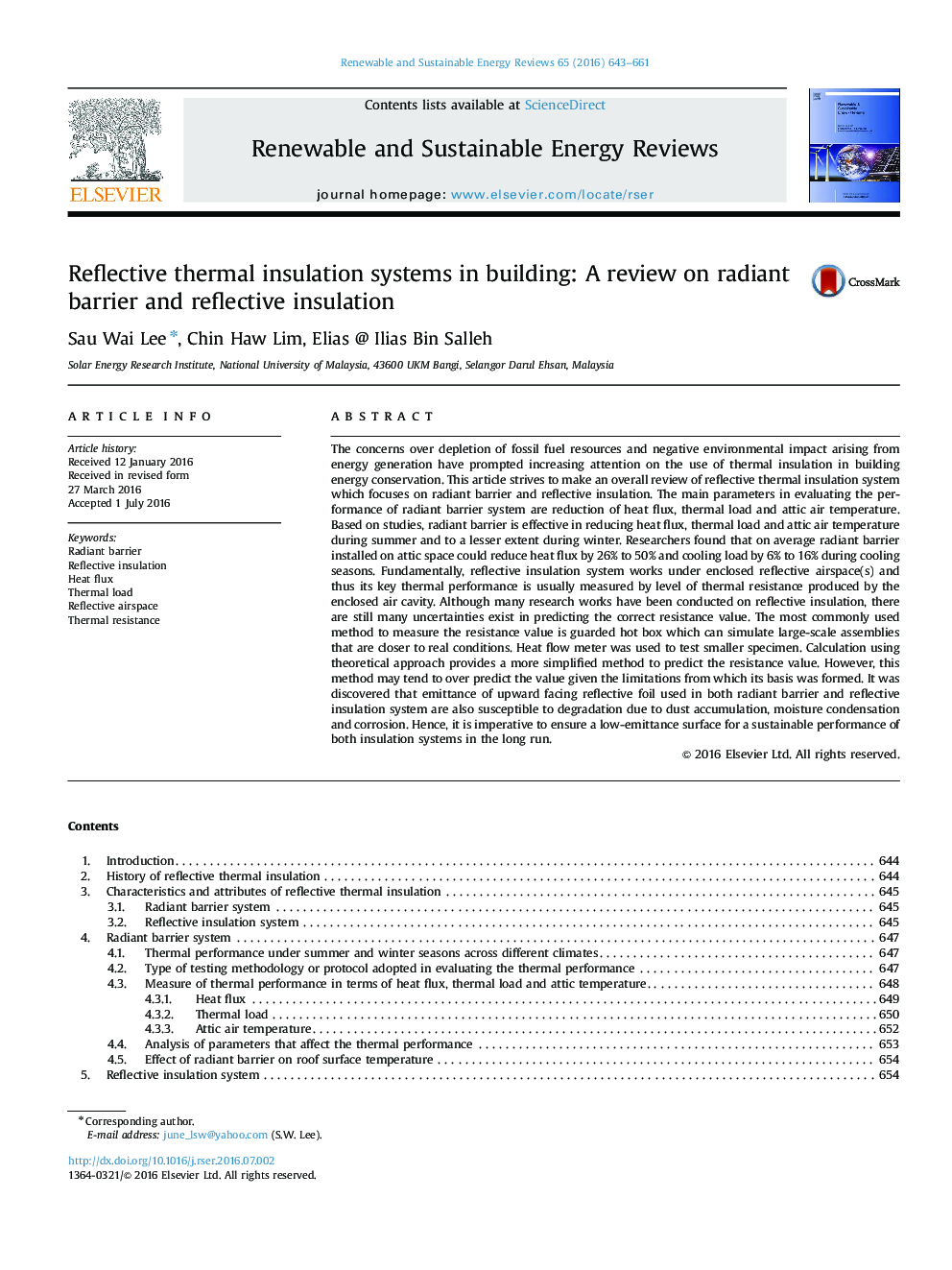| کد مقاله | کد نشریه | سال انتشار | مقاله انگلیسی | نسخه تمام متن |
|---|---|---|---|---|
| 8112956 | 1522320 | 2016 | 19 صفحه PDF | دانلود رایگان |
عنوان انگلیسی مقاله ISI
Reflective thermal insulation systems in building: A review on radiant barrier and reflective insulation
ترجمه فارسی عنوان
سیستم های عایق حرارتی بازتابنده در ساختمان: بررسی بر روی مانع تابشی و عایق بازتابنده
دانلود مقاله + سفارش ترجمه
دانلود مقاله ISI انگلیسی
رایگان برای ایرانیان
کلمات کلیدی
مانع شفاف، عایق بازتابنده، شار حرارتی، بار حرارتی، فضای هوایی انعکاسی، مقاومت حرارتی،
ترجمه چکیده
نگرانی ها در مورد کاهش منابع سوخت فسیلی و اثرات منفی زیست محیطی ناشی از تولید انرژی موجب توجه بیشتر به استفاده از عایق حرارتی در ایجاد انرژی شده است. این مقاله تلاش دارد تا بررسی کلی سیستم عایق حرارتی بازتابنده را که بر روی مانع تابشی و عایق بازتابی متمرکز شده است، انجام دهد. پارامترهای اصلی در ارزیابی عملکرد سیستم مانع تابشی، کاهش شار حرارتی، بار حرارتی و دمای هوا در اطاق است. بر اساس مطالعات، مانع تابشی در کاهش تابش گرما، بار حرارتی و دمای هوای اتاق در تابستان و به میزان کم در زمستان موثر است. محققان دریافتند که به طور متوسط مانع تابشی در فضای اتاق زیر شیروانی می تواند شار حرارت را به میزان 26٪ تا 50٪ و بار خنک کننده طی 6 تا 16٪ کاهش دهد. اساسا، سیستم عایق بازتابی تحت محفظه بازتابنده هواپیما (ها) کار می کند و بنابراین عملکرد حرارتی کلیدی آن معمولا توسط سطح مقاومت حرارتی ساخته شده توسط حفره هوای محصور شده اندازه گیری می شود. اگر چه بسیاری از تحقیقات روی عایقهای بازتابی انجام شده است، هنوز در مورد پیش بینی ارزش مقاومت درست وجود دارد. روش معمولی برای اندازه گیری مقدار مقاومت، جعبه ی داغ محافظت می شود که می تواند مجموعه های مقیاس بزرگ را که به شرایط واقعی نزدیک می شوند شبیه سازی کند. برای اندازه گیری نمونه های کوچک تر، از گرماسنج استفاده شد. محاسبه با استفاده از روش نظری یک روش ساده تر برای پیش بینی مقدار مقاومت ارائه می دهد. با این حال، این روش ممکن است بیش از حد پیش بینی ارزش با توجه به محدودیت هایی که از آن پایه تشکیل شده است. کشف شد که انتشار فویل بازتابنده رو به بالا که در هر دو مانع تابشی و سیستم عایق بازتابی استفاده می شود نیز به علت انباشت گرد و غبار، تراکم رطوبت و خوردگی حساس هستند. از این رو ضروری است که یک سطح پایین تضمین برای عملکرد پایدار هر دو سیستم عایق در طولانی مدت اطمینان حاصل شود.
موضوعات مرتبط
مهندسی و علوم پایه
مهندسی انرژی
انرژی های تجدید پذیر، توسعه پایدار و محیط زیست
چکیده انگلیسی
The concerns over depletion of fossil fuel resources and negative environmental impact arising from energy generation have prompted increasing attention on the use of thermal insulation in building energy conservation. This article strives to make an overall review of reflective thermal insulation system which focuses on radiant barrier and reflective insulation. The main parameters in evaluating the performance of radiant barrier system are reduction of heat flux, thermal load and attic air temperature. Based on studies, radiant barrier is effective in reducing heat flux, thermal load and attic air temperature during summer and to a lesser extent during winter. Researchers found that on average radiant barrier installed on attic space could reduce heat flux by 26% to 50% and cooling load by 6% to 16% during cooling seasons. Fundamentally, reflective insulation system works under enclosed reflective airspace(s) and thus its key thermal performance is usually measured by level of thermal resistance produced by the enclosed air cavity. Although many research works have been conducted on reflective insulation, there are still many uncertainties exist in predicting the correct resistance value. The most commonly used method to measure the resistance value is guarded hot box which can simulate large-scale assemblies that are closer to real conditions. Heat flow meter was used to test smaller specimen. Calculation using theoretical approach provides a more simplified method to predict the resistance value. However, this method may tend to over predict the value given the limitations from which its basis was formed. It was discovered that emittance of upward facing reflective foil used in both radiant barrier and reflective insulation system are also susceptible to degradation due to dust accumulation, moisture condensation and corrosion. Hence, it is imperative to ensure a low-emittance surface for a sustainable performance of both insulation systems in the long run.
ناشر
Database: Elsevier - ScienceDirect (ساینس دایرکت)
Journal: Renewable and Sustainable Energy Reviews - Volume 65, November 2016, Pages 643-661
Journal: Renewable and Sustainable Energy Reviews - Volume 65, November 2016, Pages 643-661
نویسندگان
Sau Wai Lee, Chin Haw Lim, Elias @ Ilias Bin Salleh,
